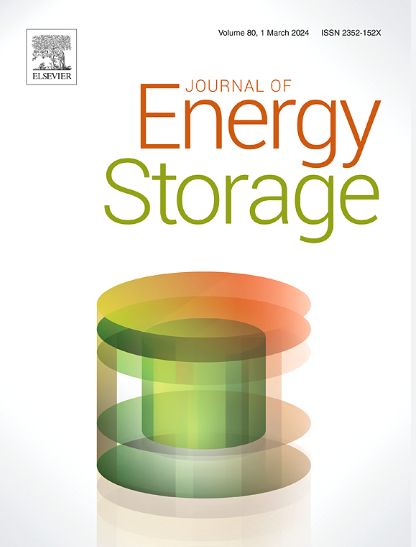伪无源动力电池热失控传播抑制系统仿真与分析
IF 8.9
2区 工程技术
Q1 ENERGY & FUELS
引用次数: 0
摘要
无源动力电池热失控传播抑制技术能够在没有外部电源的情况下阻止热失控的传播,对电动汽车的安全性具有重要意义,受到了广泛的关注。现有的被动热失控传播抑制方法以隔热为基础,导致电池间热阻较大,与热管理不兼容。针对上述问题,提出了集伪被动散热和隔热于一体的伪被动动力电池热失控传播抑制系统。建立了基于拟被动排热集总参数模型和热失控传播三维模型的系统模型,并对其进行了验证。仿真结果与实验结果吻合较好,平均偏差为6.91%。此外,还对系统性能进行了评估,并与现有的被动方法进行了比较。结果表明,该伪被动排热工艺解决了电池阵列产生热量的24.6%,阻止热失控传播所需的热阻降低了48 ~ 85%。本文为动力电池热失控传播抑制技术提供了新的见解,有利于提高电动汽车的安全性。本文章由计算机程序翻译,如有差异,请以英文原文为准。
Simulation and analysis of pseudo-passive power battery thermal runaway propagation inhibition system
Passive power battery thermal runaway propagation inhibition technologies, being able to block the thermal runaway without external power sources, are highly important for the safety of electric vehicles and have attracted extensive attention. The existing passive thermal runaway propagation inhibition approach is based on thermal insulation, leading to the large thermal resistance between batteries and incompatibility with thermal management. In this regard, the pseudo-passive power battery thermal runaway propagation inhibition system, integrating with pseudo-passive heat removal and thermal insulation, is proposed to address the above-mentioned issue. The system model, based on the lumped parameter model of pseudo-passive heat removal and the 3D model of thermal runaway propagation, is developed and verified. A good agreement of the simulation and experiment data is shown, i.e., the average deviation is 6.91 %. Furthermore, the system performance is assessed and compared with the existing passive approach. Results display that the pseudo-passive heat removal process addresses 24.6 % of the heat generation of the battery array, and the thermal resistance necessary to stop the thermal runaway propagation comes down by 48–85 %. The paper provides new insight into power battery thermal runaway propagation inhibition technologies, and is favorable to enhance the safety of electric vehicles.
求助全文
通过发布文献求助,成功后即可免费获取论文全文。
去求助
来源期刊

Journal of energy storage
Energy-Renewable Energy, Sustainability and the Environment
CiteScore
11.80
自引率
24.50%
发文量
2262
审稿时长
69 days
期刊介绍:
Journal of energy storage focusses on all aspects of energy storage, in particular systems integration, electric grid integration, modelling and analysis, novel energy storage technologies, sizing and management strategies, business models for operation of storage systems and energy storage developments worldwide.
 求助内容:
求助内容: 应助结果提醒方式:
应助结果提醒方式:


